
The European market potential for macadamia nuts
Macadamia nuts are seen as luxury products compared to other nuts and many European consumers currently consider them too expensive. However, a price decrease is expected, and this is likely to lead to increased consumption. Most macadamia nuts in Europe are currently used by roasting companies, but they are increasingly being used in ice cream toppings and healthy food products. The most attractive import markets at the moment are Germany and the Netherlands.
Contents of this page
1. Product description
This study describes the European market for macadamia nut kernels, which are the edible part of the macadamia nut seed. Macadamia is a tropical evergreen tree that belongs to the genus Macadamia of the Proteaceae family. Macadamias are native to Australia although they are grown in many other tropical areas. There are several Macadamia species, but only two are of commercial importance in international trade. These are Macadamia integrifolia (which has a smooth shell) and Macadamia tetraphylla (which has a rough shell).
Figure 1: A macadamia tree
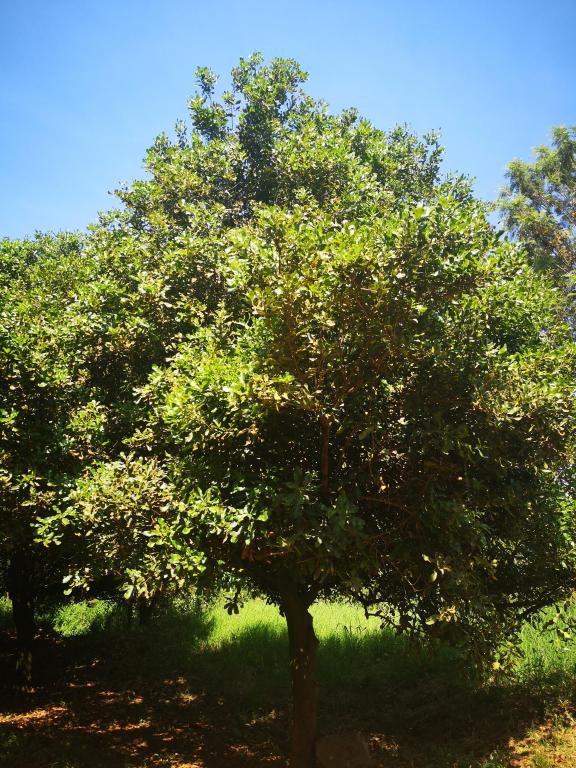
Source: Autentika Global
Growers worldwide prefer grafted Macadamia integrifolia cultivars as they give better yields compared to M. tetraphylla. It is also a preferred species for roasting as it has a lighter colour. M. tetraphylla contains more sugar. This means that, after roasting, the nuts are darker compared to M. tetraphylla. The higher sugar content of M. tetraphylla is also useful for nut spreads, cookies and other sweet snacks. The importance of Macadamia tetraphylla is decreasing, but it still accounts for a significant share of production in Kenya.
The nuts grow encased in hard, woody shells, protected by green-brown fibrous husks that split open as the nuts mature. When fully mature, nuts fall naturally. They are then gathered from the ground. There are usually two harvesting seasons per year.
Figure 2: Macadamia nut on a tree
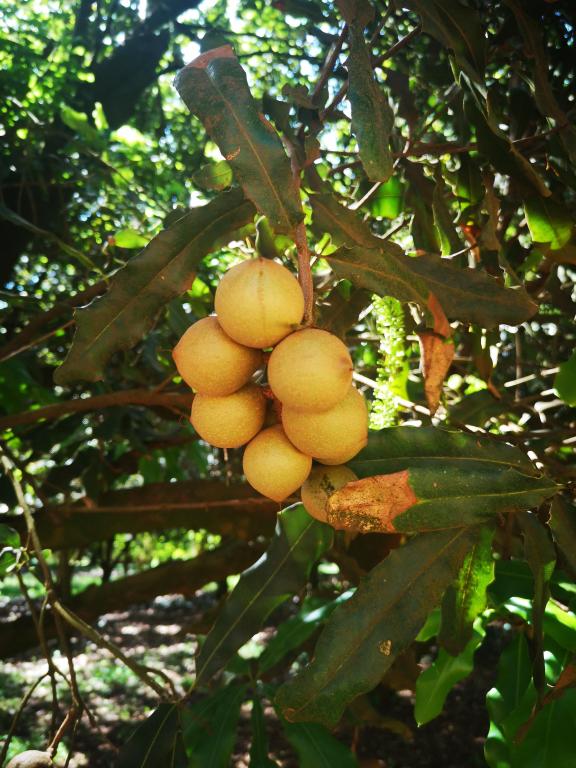
Source: Autentika Global
After harvesting, the production of macadamia nut kernels usually involves the following steps:
- De-husking – removing the outer husk right after harvesting
- Cleaning of in-shell nuts
- Drying – moisture level is reduced to below 1.5% so they can be cracked immediately after drying
- Sorting of in-shell nuts as preparation for cracking
- Cracking – usually by machines with adjustable sizes between rollers
- Removing shells from the kernels – this is often done with optical sorting machines
- Grading – sizing, removing defective nuts, cutting, grading into quality categories
- Packing
The product is frequently used as an ingredient in Australia, the United States and Japan. In Europe, macadamia nuts are mainly used as snacks (usually roasted and salted). However, as world supply grows, the interest from various industries in Europe is increasing. As an ingredient, macadamia nuts are used in Europe in ice creams, but they are being used in increasing numbers of other products. Macadamia oil is mostly used in the cosmetics industry in Europe but very rarely as food.
Figure 3: Macadamia nut raw kernels
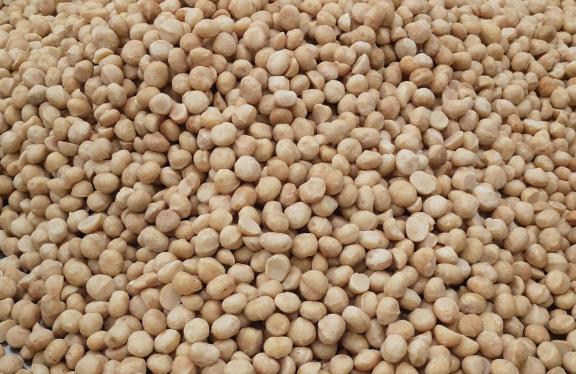
Source: Autentika Global
This study covers general information regarding the market for macadamia kernels in Europe, which is of interest to producers in developing countries. When the study refers to ‘Europe,’ this includes the 27 member states of the European Union, plus the United Kingdom, Switzerland, Norway, Iceland and Liechtenstein. Developing countries are defined as the countries that are listed as official development assistance recipients. For a statistical analysis of the European market, the following combined nomenclature code is used: 080262.
2. What makes Europe an interesting market for macadamia nuts?
Europe is the second-largest importer of macadamia nut kernels in the world after the United States. Europe accounts for around one third of total world imports. Although Europe’s total imports of macadamia nuts are stagnating, there are still opportunities for suppliers from developing countries. While imports from Australia are decreasing, the import from developing countries is increasing (Figure 1). Over the last 5 years, the European import from developing countries has increased by an annual rate of 4%.
During 2022 and 2023, the demand for macadamia nuts in Europe stagnated due to inflation. This inflation started after the COVID-19 outbreak in 2020 and worsened due to the energy crisis caused by the war in Ukraine in 2022. Macadamia nuts are considered luxury nuts and are the most expensive nuts on the European market. In 2022 and 2023, for end consumers, macadamias were twice as expensive as cashews on average and 5 to 6 times more expensive than peanuts.
Despite temporary flat demand, the European market for macadamia nuts is likely to increase at an annual rate of 3-5% over the next 5 years. Due to the oversupply of macadamia nuts, a decrease in export prices is forecasted. This should make macadamia nuts more affordable. Macadamia nuts have a unique taste, which many European consumers do not know about. Consumption will also probably increase following the expected promotion of their health benefits.
Regular changes in import volumes will continue, affected by crop volumes and price situations, rather than changes in demand. Due to climate change, more fluctuation in the global crop can be expected. Although the demand for macadamia nuts in Europe is stable, it is affected by price changes on the supply side.
Source: Global Trade Atlas
European imports of macadamia kernels fluctuated between 2018 and 2022. The average annual import growth in volume was 2%, but there was a decrease of 0.4% in value over the same period. This difference in growth indicates a decrease in price. In 2022, European imports reached 7,700 tonnes, with a value of €110 million. European imports from developing countries have increased by more than 1,000 tonnes over the last 5 years; from 5,600 tonnes in 2018 to 6,700 tonnes in 2022.
Internal European trade accounts for an additional 3,100 tonnes. Internal European trade consists of simple re‑exporting of imported raw macadamia nut kernels, but it also includes added-value processes, such as roasting.
3. Which European countries offer the most opportunities for macadamia nuts?
As macadamia nuts are not produced in Europe and re-exports to outside Europe is insignificant, the total European consumption is almost the same as imports. European consumption of macadamia nuts in 2022 was estimated at 6,100 tonnes. Over the last 5 years, consumption has increased at an annual growth rate of 8%. Germany, the Netherlands, Spain, France, the United Kingdom and Switzerland are the largest markets. According to the INC, estimated per capita consumption in Germany is the highest in Europe, at 203 g/year in 2021.
European consumers are becoming increasingly aware of the health benefits of nuts. Macadamia nuts are promoted as being especially rich in fibre, magnesium, copper, manganese and thiamine. Another driving force of the increased consumption of macadamia nuts is their taste. Many European consumers find the taste of macadamia nuts appealing and different from other nuts, mostly because of the buttery flavour.
Source: ITC TradeMap and Eurostat
Note that the figure above represents the apparent consumption (the difference between imports and exports). There is no exact data about consumption per country. A rough calculation is available from the International Nuts and Dried Fruit Council (INC), but the data is incomplete.
The main countries that consume macadamias in Europe are also the main importers, as shown in Figure 6 below. The main outlier is the higher position of the Netherlands as it is mostly a transit country. Most imported quantities are not consumed in the country but re-exported to other European countries. The most attractive macadamia markets for macadamia suppliers in Europe are Germany, the Netherlands, Spain, France, the United Kingdom and Switzerland.
Source: ITC TradeMap and Eurostat
Significant quantities of macadamia nuts are also imported to Luxembourg. This may seem surprising since Luxembourg is one of the smallest European countries with very limited consumption. This is because the processing and packing facilities for many edibles are located in Luxembourg, so it is mainly a transit country.
Germany: by far the largest European macadamia consumer
Germany is Europe’s largest importer of macadamia nuts. In 2022, Germany imported 3,300 tonnes, at a value of €48.7 million. German consumption of macadamia nuts was around 2,600 tonnes in 2022. This is more than 40% of total European consumption. Around 20% of the imports are re-exported to other European countries with the highest share being sold to the Netherlands, France and Switzerland. Specialised traders and agents perform re-export activities. Many of them are located in Hamburg (Germany’s main port).
In 2022, Germany imported 43% of its macadamia kernels from South Africa, followed by Kenya (18%), Australia (12%), Vietnam (2%) and Malawi (2%). Germany imported 18% of its macadamia nuts from the Netherlands (re-exports). Germany showed stable and strong growth of import until 2021, peaking at 4,400 tonnes. However, due to inflation, macadamia nuts became too expensive for many German consumers, and this led to a decrease in imports from all main origins.
Most macadamia nuts are sold through German discounters, such as ALDI Süd, ALDI Nord and LIDL. These discounters are also present in several other European countries, but most of them have centralised purchasing departments in Germany. For example, Lidl currently operates around 12,000 stores in 31 countries. This means that some of the macadamia nuts purchased by Lidl is re-exported to other countries.
Figure 7: A private label (Rossmann) of roasted and salted macadamia nuts in Germany
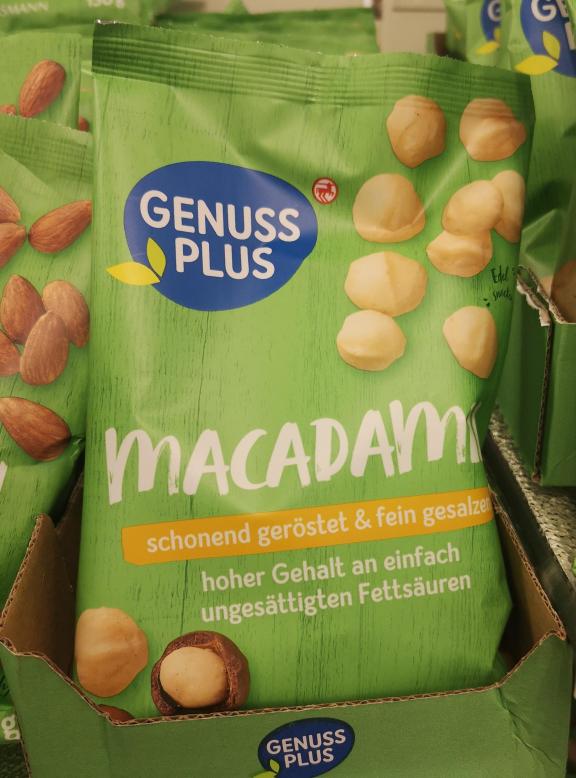
Source: Autentika Global
Germany is a particularly attractive market for organic macadamias, as it is the largest European market for organic food. A large share of organic macadamia nuts is sold under retail chains’ private labels. This includes specialised organic retailers like BioMarkt, Alnatura, Rossmann and DM. There are also independent organic brands, such as Rapunzel, Morgenland and KoRo (online retailer). New suppliers must be aware of the competition in the organic segment in Germany, such as Limbua, which produces nuts in Kenya.
Figure 8: Unsalted organic macadamia in Germany (by Alnatura)
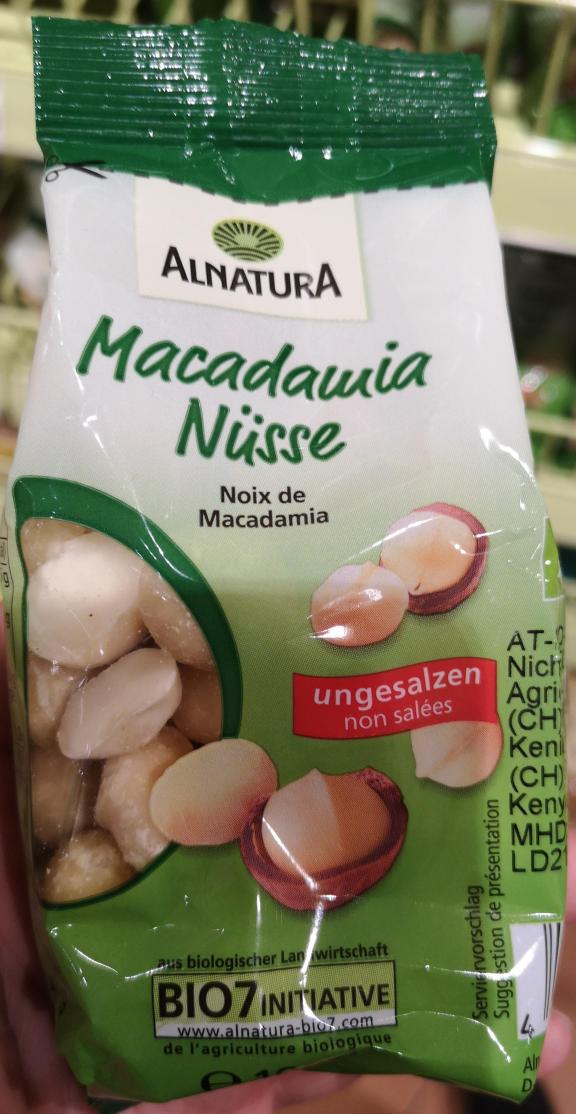
Source: Autentika Global
Macadamia nuts are mainly sold on the German market as luxury roasted and salty snacks. A new trend in the snacking segment is the growing retail sales of non-salted nuts that can be used as ingredients in home cooking. Macadamia nuts are also increasingly being used as an ingredient, especially for ice cream toppings. Another interesting new development is organic nut spreads (e.g. Vitaquell, Nutfields, BioGourmet and Rapunzel).
Figure 9: Roasted unsalted macadamia nuts in Germany (by Seeberger)
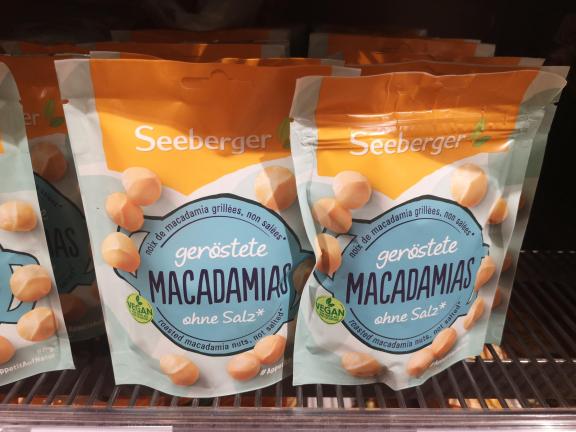
Source: Autentika Global
Some examples of German macadamia nut importers include Seeberger, Horst Walberg Trockenfrucht Import, Kluth and PALM Nuts & More Nuß und Trockenfrucht. Some retail brands are Max (by Max Kiene), Seeberger and Farmer’s Snack. Apart from independent brands, many cashew nuts are sold under retailers’ brands (private labels). Some leading private labels include Alesto (by Lidl), Trader Joe’s (by Aldi Nord), Farmer (by Aldi Süd), K-Classic (by Kaufland), ja and REWE Beste Wahl (by REWE) and Gut & Günstig and EDEKA (by EDEKA).
Tips:
- Find German traders of macadamia nuts on the websites of the specialised German Association – Waren-Verein and in the German company directory – Wer Liefert Was.
- To get in touch with organic suppliers and traders in Germany, visit Biofach – the world’s largest trade fair for organic food. It is held every year in February in Nuremberg.
Spain: supply dominated by Africa
Spain is the second-biggest consumer and importer of macadamia nuts in Europe. Like the rest of Europe, Spanish imports of macadamia kernels peaked in 2021, with 983 tonnes, but decreased in 2022 to 756 tonnes. However, the market quickly showed the first signs of recovery and imported quantities in the first half of 2022 were already higher compared with the same period in 2021. The main reason for the market recovery was a price decrease. Average import prices in 2023 in Spain are 25% to 30% lower compared to 2022.
The Spanish supply is very concentrated, with South Africa and Kenya representing 85% of the market share. In 2022, Spain imported 56% of its macadamia nuts from South Africa, followed by Kenya (a 29% share), Australia (5%), Guatemala (3%) and the Netherlands (2%, a transit country). Kenya is increasing its share of the Spanish market. Spanish imports from Kenya increased from 37 tonnes in 2018 to 223 tonnes in 2022.
The majority of macadamia nuts in Spain are consumed as a snack. Retail sales are dominated by private labels (retail chain own brands) such as Mercadona (Hacendado label), Carrefour (Classic label), Lidl (Alesto label), Alcampo (Auchan label), Eroski, Dia and Aldi. Private labels are often packed by companies that also have their own brands, such as Frutos Secos or Frit Ravich. An important importer is the company Importaco, which developed its own B2B brand Itac Professional, and acquired a 51% stake in Italian trader Besana in 2020.
Figure 10: A private label of the retail chain Mercadona in Spain

Source: Autentika Global
Tips:
- Visit the Alimentaria trade fair to get in touch with Spanish nut suppliers. It is held every other year in Barcelona in March.
- Visit the website of the Spanish Sweet Association to find potential users of macadamia nuts as an ingredient.
The Netherlands: a trade hub
The Netherlands is an important importer of macadamia nuts in Europe, accounting for 37% of total European imports. Its imports peaked in 2021, with almost 2,600 tonnes but decreased to 2,200 tonnes in 2022. The Netherlands plays an important role as a trade hub in Europe. In 2022, 72% of all imported macadamia kernels were re-exported to other European countries. Germany is the leading destination of Dutch re-exports of macadamia nuts, accounting for 68% of the total re-export.
The Netherlands imports 71% of its macadamia nuts from developing countries. The leading supplier to the Netherlands in 2022 was South Africa with a 35% share, followed by Kenya (15%), Australia (11%), Mozambique (11%), Malta (8% as re-export) and Guatemala (8%). Fluctuation in imports to the Netherlands reflects demand in Europe as a whole. However, the Netherlands is also a significant consumer of macadamia nuts, with an estimated annual consumption of 131 g per capita in 2021.
Similar to other European countries, consumption of macadamia nuts in the Netherlands is increasing, driven by the healthy snacking trend and the use of nuts as a substitute for animal proteins. They are mainly used as snacks, and frequently sold in a mixture with other tree nuts in 150-200g packaging containers. Most of the quantities are sold as private labels packed by specialised companies (for example Foodtrend). Apart from snacking, macadamia nuts are increasingly being used as an ingredient, especially in cookies.
Dutch consumers and traders of nuts are increasingly demanding sustainable and ethical sourcing. Sustainable sourcing in the Netherlands is supported by several initiatives like the Sustainable Nut Initiative, Woord en Daad and Fair Match Support. Woord en Daad is launching a project to support macadamia nut farmers in Mozambique.
Examples of Dutch macadamia nut importers include Catz International, Delinuts, Rhumveld and Nutland. The Netherlands is a highly demanding market, as most macadamia nuts are sold to consumers as private label brands (brands of retailers), such as of Albert Heijn, Jumbo or Lidl. The consumption of unbranded, freshly-roasted nuts is also significant. An important shift is also seen in the usage of sea salt over table salt and roasting over frying in oil.
Tip:
- To learn more about the Dutch macadamia nut market, contact the Dutch Association for trade in dried fruit, nuts, spices and related products (website in Dutch only).
France: increase in imports despite price inflation
French imports of macadamia nuts have, on average, increased by 23% in quantity and 12% in value annually between 2018 and 2022. The import of macadamia nuts to France reached 618 tonnes and €7.9 million in 2022. Despite inflation, French imports in 2022 were higher than in 2021. One of the reasons for the increase of imports is the growing use of macadamia pieces as ingredients than in many other European countries.
In 2022, the leading supplier of macadamia nuts to France was Guatemala, which had a 41% share, followed by Kenya (32%), Australia (14%), South Africa (8%) and the Netherlands (1%, as re-export). France can be an attractive market for developing-country suppliers as French traders prefer direct imports from producing countries. French imports from transit countries, like Germany or the Netherlands, are insignificant. Most imports are consumed within the country.
Large quantities of macadamia nuts in France are sold under retail chains’ private labels, such as Carrefour (Classic label), Leclerc (Tokapi label), Super U (U label) and Auchan (Auchan label). Independent brands include Sainte Lucie, Vico, Vahine, La Patelière, Daco Bello (by Daco France) and Seeberger (German brand). France offers good opportunities for sales of organic macadamia nuts as the second-largest market for organic food in Europe.
Macadamia nuts in France are mostly consumed as salty roasted snacks, although they are increasingly being used as an ingredient, especially in ice creams. A very popular ice cream brand that uses macadamia nuts in several ways, is Häagen Dazs. Häagen Dazs is an international brand (headquartered in the United States), but it is produced in the French factory of General Mills in Tilloy-lès-Mofflaines for the European market.
Tips:
- To meet French users and traders of macadamia nut kernels, visit the trade fair SIAL. It is held every other year in Paris.
- To learn more about the French macadamia nuts market, contact the French association for research in the fruit and vegetable sector (CTIFL).
- If you are not from a French-speaking country, consider investing in French-speaking staff for easier access to the French market for macadamia nuts.
The United Kingdom: a preference for South African supply
The United Kingdom is the fourth-largest consumer and the fifth-largest importer of macadamia nuts in Europe. In 2022, imports reached 458 tonnes. Consumption is almost the same as import, and re-export is insignificant (8 tonnes). Unlike most European importers, the United Kingdom did not decrease its imports in 2022 compared to 2021. In 2021, per capita consumption of macadamia nuts in the United Kingdom was estimated to be 25 g/year.
The United Kingdom market is not easy to enter, as only 6 countries supply the entire market. South Africa has a market share of more than 70%. Other suppliers are Kenya with a 16% share, Italy (as a re-exporter) with a 7% share, Malawi (4%), Guatemala (1%) and Australia (0.4%).
The market for macadamia nuts in the United Kingdom is still developing, with only a couple of direct importers. Macadamia nuts are mainly sold as snacks, although a few companies also use macadamia kernels and pieces as ingredients. Some examples include: the ice cream producer Nuii; the chocolate bar producer Cliff; the producer of low carbohydrate bars Fatt; the producer of nut spreads Nut Blend, and the producer of breakfast cereals Lizi’s.
Some examples of importers are C.G. Hacking & Sons and Freeworld Trading. Green Farms Nut Company, a South African exporter of macadamia nuts, has established a sales office in London.
Tip:
- To find macadamia nut importers in the United Kingdom, check the member list of the UK Nut & Dried Fruit Trade Association. Besides members from the United Kingdom, you can find contact details of companies from France, the Netherlands and Germany.
Switzerland: dominated by private labels
Swiss imports of macadamia nuts increased by an average of 9% in value and 10% in quantity annually between 2018 and 2022. In 2022, Swiss macadamia nuts imports reached 321 tonnes and €5.26 million. In 2022, South Africa was the leading supplier of macadamia nuts to Switzerland with a 40% volume share, followed by Australia (26%), Kenya (21%) and Germany (8%, as a transit country).
Macadamia nuts in Switzerland are mostly consumed as a roasted snack. Retail sales are dominated by private labels like Coop (Coop and Naturaplan labels) and Migros (Sun Qui, Migros Selection and Migros Bio labels). One of the leading independent brands is the German Ültje. Macadamia nuts are also sold on the Swiss market as an ingredient in ice creams (for example, the Nuii, Mövenpick, Häagen Dazs and Alnatura).
4. Which trends offer opportunities or pose threats on the European macadamia nuts market?
The increasing demand for healthy snacking combined with the need for stable and sustainable sourcing are the leading driving forces behind the growing consumer interest in macadamia nuts in Europe. With an increase in interest in vegan diets, the consumption of salty nuts (‘healthy snacking’) and nut spreads (such as macadamia nut butter) is on the rise. This is because consumers must satisfy their protein needs in the absence of animal proteins and deal with lactose intolerances.
To find out more about general trends, read our study about trends in the European processed fruit and vegetables market.
Healthy snacking
Nuts have a good reputation among European consumers. The consumption of nuts is expected to increase in the snack segment, but consumers are making more planned purchases and fewer impulsive ones. The main obstacle for macadamia nuts is their high price compared to other nuts. According to research by Euromonitor International, consumers will continue to purchase snacks, but affordability is becoming a very important factor.
Macadamia nuts’ health benefits are still unknown to a large share of the European population. Although they are known to be rich in monosaturated fat and in antioxidants, there is still little official or validated clinical research related to macadamia nuts consumption. In order to promote consumption, the World Macadamia Organisation is planning to finance more scientific studies into the health benefits of macadamia nuts.
Macadamia nuts provide specific nutritional benefits, which are slightly different from most other nuts. Like other nuts, macadamia nuts are considered a healthier alternative to other savoury snacks, such as crisps and extruded snacks. However, macadamia nuts have a high oil content compared to other nuts. This makes them a better option for low carbohydrate diets. The British company Fatt uses this feature to produce bars suitable for the ketogenic diet (high in fat and low in carbohydrates).
Another potential benefit of macadamia snacking is an improvement of the brain function. Although there is no specific research into macadamia nuts’ effects on brain function and ageing, some studies indicate that eating macadamia nuts may improve brain function. If this claim were based on clinical research, it could boost macadamia nut consumption in the near future. This is because, according to MINTEL research, some consumers are interested in ingredients that enhance cognitive capacity (so called ‘nootropics’).
Sustainable sourcing
Sustainability certification in the edible nut trade was once used to target niche markets (such as Fairtrade), but now sustainability claims and certification are one of the main trends in the mainstream market. In 2020, the European Union established an official policy called the European Green Deal, which includes the Farm to Fork Strategy and the Biodiversity Strategy. Both policies influence food production and trade. To learn more about European sustainability demands, read the CBI’s study Tips to go green and CBI’s Tips to become sustainable supplier.
In the edible nut sector, several large traders have joined the Sustainable Nut Initiative with the objective of stimulating traceability and sustainability. The initiative provides a management information system (3S — Sustainable Supply System), alongside many other tools. The system aims to stimulate productivity and quality and to create traceability and transparency in the supply chain.
Transparency in the supply chain is becoming extremely important for European consumers. They want to know more about the origins of their groceries, and they prefer suppliers who respect human rights and treat farmers fairly.
A good example of a sustainable partnership is the German-Kenyan company Limbua, which has become one of the largest suppliers of organic macadamia nuts in Europe. Limbua cooperates with 5,000 small-scale farmers. It operates modern, decentralised production facilities at small-scale farms. This approach helps small-scale farmers to add value to their products. Limbua has also established a foundation, which supports research and education that promote rural development through sustainable small-scale farming and crop processing.
Macadamia nuts as an ingredient
Macadamia nuts are also increasingly being used as an ingredient in healthy and functional food products, such as macadamia fruit and nut bars (Eat Natural), breakfast cereals (Byron Bay), macadamia nut butter (Alnatura), nut bars (Primal Pantry) and chocolate products with macadamia nuts (Ritter Sport). A particularly high increase in usage can be seen in the ice cream industry. Macadamia nuts have a pleasant, buttery flavour and add a specific texture. In order to increase the global consumption of macadamia nuts, the Australian Macadamia Society organises the Macadamia Challenge competition.
Note that the use of macadamia nut oil in cosmetic products is already established in the European market, with plenty of new products and brands.
Tips:
- Promote the applications and nutritional properties of macadamia nuts. However, avoid health or nutritional claims that are unsubstantiated by scientific evidence. Take a look at the Health Research Database of INC to find studies published in scientific journals.
- Read the CBI’s Market Statistics and Outlook study on Processed Fruit, Vegetables and Edible nuts to learn more about general trade trends and the size of specific market segments.
- Check the websites of European trade shows and exhibitions to discover the newest trends. The most important trade fairs in Europe that are relevant for macadamia nut trends and trade are SIAL, Anuga and BioFach
- Visit SIAL innovation online for insights into the latest food innovations in 2020.
Autentika Global and updated by M-Brain carried out this study on behalf of CBI.
Please review our market information disclaimer.
Search
Enter search terms to find market research